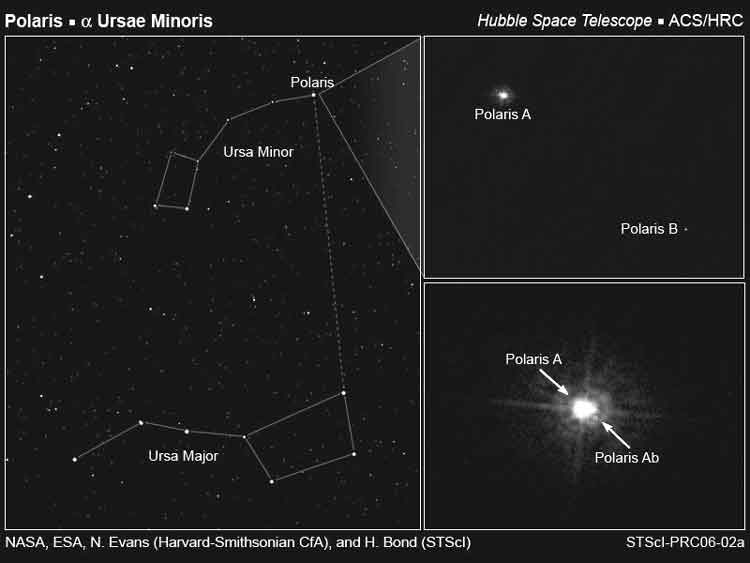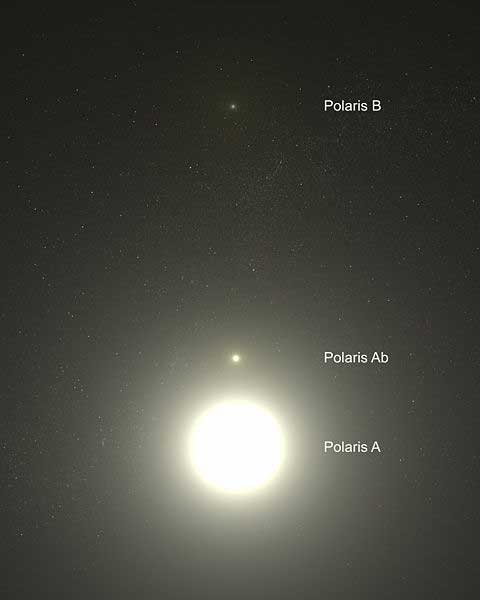- ^ Cayrel de Strobel, G.; Soubiran, C.; Ralite, N. (2001). " Catalogue of [Fe/H] determinations for FGK stars: 2001 edition ". A&A 373: 159-163.
- ^ There's More to the North Star Than Meets the Eye
- ^ Evans, N. R.; Schaefer, G.; Bond, H.; Bono, G.; Karovska, M.; Nelan, E.; Sasselov, D. (January 9, 2006). "Direct detection of the close companion of Polaris with the Hubble Space Telescope". American Astronomical Society 207th Meeting.
- ^ Nathaniel Bowditch: The American Practical Navigator, 2002 Bicentennial Ed., Chapter 15 Navigational Astronomy, page 248, Figure 1530a. Navigational stars and the planets
- ^ Mathematical Astronomy Morsels, Meeus, J., Willmann-Bell Inc., Richmond, Virginia, 1997, p.308. ISBN 0 943396 51 4
- ^ Bailey, Clinton (1974). "(abstract) Bedouin Star-Lore in Sinai and the Negev". Bulletin of the School of Oriental and African Studies, University of London 37 (3): 580-96. Retrieved on 2008-01-14.
- ^ Cooper, JC (1992). Symbolic and Mythological Animals. London: Aquarian Press, 163. ISBN 1-85538-118-4.
Polaris as seen by the Hubble Space Telescope.
Polaris (α UMi / α Ursae Minoris / Alpha Ursae Minoris), more commonly known as the North(ern) Star or the Pole Star, and sometimes known as the Lodestar, is the brightest star in the constellation Ursa Minor. It is very close to the north celestial pole (42′ away as of 2006), making it the current northern pole star. Polaris is 431.42 light-years from Earth. Concerning the detailed physics, α UMi A is an F7 bright giant (II) or supergiant (Ib). The two smaller companions are: α UMi B, an F3V main sequence star orbiting at a distance of 2400 AU, and α UMi Ab, a very close dwarf with an 18.5 AU radius orbit. Recent observations show that Polaris may be part of a loose open cluster of type A and F stars. Polaris B can be seen with even a modest telescope and was first noticed by William Herschel in 1780. In 1929, it was discovered by examining the spectrum of Polaris A that it had another very close dwarf companion (variously α UMi P, α UMi a or α UMi Ab), which had been theorized in earlier observations (Moore, J.H and Kholodovsky, E. A.). In January 2006, NASA released images from the Hubble telescope, directly showing all three members of the Polaris trinary system. The nearer dwarf star is in an orbit of only 18.5 AU (2.8 billion km;[2] about the distance from our Sun to Uranus) from Polaris A, explaining why its light is swamped by its close and much brighter companion.[3] Polaris is a classic Population I Cepheid variable (although it was once thought to be Population II due to its high galactic latitude). Since Cepheids are an important standard candle for determining distance, Polaris (as the closest such star) is heavily studied. Around 1900, the star luminosity varied ±8% from its average (0.15 magnitudes in total) with a 3.97 day period; however, the amplitude of its variation has been quickly declining since the middle of the 20th century. The variation reached a minimum of 1% in the mid 1990s and has remained at a low level. Over the same period, the star has brightened by 15% (on average), and the period has lengthened by about 8 seconds each year. Recent research reported in Science suggests that Polaris is 2.5 times brighter today than when Ptolemy observed it (now 2mag, antiquity 3mag). Astronomer Edward Guinan considers this to be a remarkable rate of change and is on record as saying that "If they are real, these changes are 100 times larger than [those] predicted by current theories of stellar evolution."
An artist's concept of Polaris' system, NASA Pole Star Because α UMi lies nearly in a direct line with the axis of the Earth's rotation "above" the North Pole — the north celestial pole — Polaris stands almost motionless on the sky, and all the stars of the Northern sky appear to rotate around it. Therefore, it makes an excellent fixed point from which to draw measurements for celestial navigation and for astrometry. The antiquity of its use is attested by the fact that it is found represented on the earliest known Assyrian tablets. In more recent history it was referenced in Nathaniel Bowditch's 1802 book, The American Practical Navigator, where it is listed as one of the navigational stars.[4] At present, Polaris is 0.7° away from the pole of rotation (1.4 times the Moon disc) and hence revolves around the pole in a small circle 1½° in diameter. Only twice during every sidereal day does Polaris accurately define the true north azimuth; the rest of the time it is only an approximation and must be corrected using tables or a rough rule of thumb. Due to the precession of the equinoxes, Polaris will not always be the pole star. Over tens of thousands of years, perturbations to the Earth's axis of rotation will cause it to point to other regions of the sky, tracing out a circle. Other stars along this circle were the pole star in the past and will be again in the future, including Thuban and Vega. Polaris has been close to the actual position of the north pole for over 1000 years and during the course of the 21st century it will continue to approach the exact theoretical position, reaching its closest approach on 24 March 2100 (almost 0.45° away). Subsequently it will begin to pull away.[5] In the Northern Hemisphere, it's easy to find Polaris by following the line traced from Merak to Dubhe (β and α Ursae Majoris, also known as the Pointers), the two stars at the end of the bowl of the Big Dipper (or Plough). One can also follow the central point of the "W" shape of Cassiopeia. Polaris is not visible from the Southern Hemisphere except from an elevated position near the equator. Polaris's fame as the North Star has given rise to a persistent misconception that it is the brightest star in the sky. Although Polaris is a relatively bright star and is conspicuous since no other stars of similar brightness are close to it, it is nowhere near the brightest; it is actually the 48th brightest star in the night sky. The brightest star in the night sky is Sirius (see List of brightest stars). There is no real southern pole star. The only star visible to the naked eye that is close to the south celestial pole is the dim Sigma Octantis, sometimes called Polaris Australis. However, the bright Southern Cross (Crux) points fairly accurately towards the south celestial pole. Etymology and cultural significance To the Bedouin people of the Negev and Sinai, Polaris is known as الجديّ al-jadiyy, "the billy goat". It and Suhail (= Canopus, α Car) are the two principal stars used for nomadic wandering at night. Because it was circumpolar and hence always visible, it became associated with a steadfast nature, as opposed to Suhail, which disappears below the horizon and hence 'flees'.[6] A monkey's head is the emblem of the Mayan god of the pole star.[7] See also * Polaris in fiction References
Links
Retrieved from "http://en.wikipedia.org/"
|
|
||||||||||||||||||||||||||||||||||||||||||||||||||||||||||||||||


